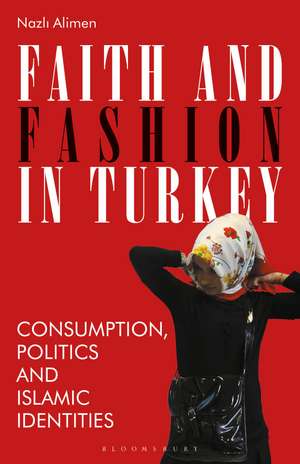Faith and Fashion in Turkey: Consumption, Politics and Islamic Identities
Autor Nazli Alimenen Limba Engleză Paperback – 21 aug 2019
Preț: 231.42 lei
Preț vechi: 297.41 lei
-22% Nou
Puncte Express: 347
Preț estimativ în valută:
44.28€ • 46.33$ • 36.79£
44.28€ • 46.33$ • 36.79£
Carte tipărită la comandă
Livrare economică 03-17 aprilie
Preluare comenzi: 021 569.72.76
Specificații
ISBN-13: 9781350129320
ISBN-10: 1350129321
Pagini: 336
Ilustrații: 23 bw illus
Dimensiuni: 138 x 216 x 25 mm
Greutate: 0.38 kg
Editura: Bloomsbury Publishing
Colecția Bloomsbury Visual Arts
Locul publicării:London, United Kingdom
ISBN-10: 1350129321
Pagini: 336
Ilustrații: 23 bw illus
Dimensiuni: 138 x 216 x 25 mm
Greutate: 0.38 kg
Editura: Bloomsbury Publishing
Colecția Bloomsbury Visual Arts
Locul publicării:London, United Kingdom
Notă biografică
Nazli Alimen is a research fellow at Helsinki University. She holds a PhD in Cultural Studies and Marketing from University of the Arts London. Her research interests include visual and material cultures, particularly fashion and dress, consumer culture, and fashion marketing. She has published in a variety of journals as well as writing a chapter for The Routledge International Handbook of Veils and Veiling Practices.
Cuprins
Figures4Abbreviations8Glossary10Introduction15The Bourdieuan Framework of Field and Everyday Religion18The Body and Embodiment: Multiple Muslim Identities24Faith and Consumption26Spaces and Spatialities30Taking a Snapshot32Reaching Members, Holding Interviews34Outline of the Book37Chapter 1. Historical Context: Politics, Religion, Society, and the Communities42The Foundation and the Early Years of the Republic42The Return of the Restricted: Islam in Politics as Religious Populism45Political and Social Lives in the 1960s and 1970s47The 1980s and 1990s: Economic Liberalisation and its Socioeconomic Impacts50The AKP Rule: From 2002 to the present53The Communities53The Gülen Community53The Süleymanl? Community59The Menzil Community61Veiling Practices and the Headscarf Ban in Turkey62Conclusion68Chapter 2. Fields and Habitus: The Religious Field of Sunni Islam and the Community Fields70The Religious Field of Islam in Turkey: The Structure and Structural Openings71Islamic Rules of Dressing and Modesty: The Informants' References and Negotiations75Acquisition of Muslim and the Community Habitus: The Community Meetings and Worship82Being Raised with Community Habitus, Becoming one of the Community Personnel90Visual Clues to Community Identities97Strategic Changes and Different Levels within the Communities103Publicly Distinguishable Clues to Piety and Community Membership of Men107Conclusion113Chapter 3. Power and Politics: Interactions between Fields116Conflict and Conformity: Fields and Players116Religious Education and ?mam-Hatip Schools118Struggle over Authority and Activity within the Religious Field of Sunni Islam in Turkey121Field Relations: The Bureaucratic Field and Community Fields125The Community Fields: Mobility and Permeability132Faith in the Marketplace: The Gülen, Süleymanl?, and Menzil Communities138The Gülen Marketplace139The Süleymanl? Marketplace147The Menzil Marketplace155Conclusion162Chapter 4. The Body and Space: Gendered Understandings and Practices167Community Spaces and Spatial Practices169Being Veiled/Non-Veiled, Becoming Veiled: Experiences of Women179Masculinities and Femininities: In the Turkish Muslim Context and in the Faith-Inspired Communities185Visibilities and Invisibilities of 'Muslim' Women and Men: in the Turkish Context and Community Fields193Conclusion204Chapter 5. Fashion and Consumption206Religiously-Related Apparel206From Tesettürwear to the Modest Fashion Field210The Intersected and Intertwined: The Mainstream and the Modest Fashion Fields217Headcoverings: Habitus and Taste Regimes221Trends and Trendsetters of the Modest Fashion Field229Conclusion240Conclusion246Appendix259References263
Recenzii
[A] fascinating, provocative and accessible account of Turkish fashion as material culture, apposite for students at undergraduate and postgraduate level in any number of cultural and media studies programmes.
Well written and extremely readable ... We come away from the book with a greater appreciation of the country, its language, its people, and their clothing choices.
Well written and extremely readable ... We come away from the book with a greater appreciation of the country, its language, its people, and their clothing choices.
